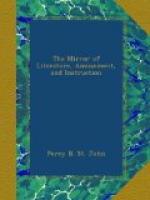Our sailors naturally substituted the appellation of John Dory for the Italian Janitore, and a very high price is sometimes given for this fish when in prime condition, as I can testify from experience; having two years since seen one at Ramsgate which was sold early in the day for eighteen shillings.
JOHNNY RAW.
* * * * *
THE SELECTOR, AND LITERARY NOTICES OF NEW WORKS.
* * * * *
“Anecdotes correspond in literature with the sauces, the savoury dishes, and the sweetmeats of a splendid banquet;” and as our weekly sheet is a sort of literary fricassee, the following may not be unacceptable to the reader. They are penciled from a work quaintly enough entitled “The Living and the Dead, by a Country Curate;” and equally strange, the cognomen of the author is not a ruse—he being a curate at Liverpool, the son of Dr. Adam Neale, and a nephew of the late Mr. Archibald Constable, the eminent publisher, of Edinburgh. The information which this volume contains, may therefore be received with greater confidence than is usually attached to flying anecdotes; since Mr. Constable’s frequent and familiar intercourse with the first literary characters of his time must have given him peculiar facilities of observation of their personal habits. The present volume of “The Living and the Dead” is what the publisher terms the Second Series; for, like Buck, the turncoat actor, booksellers always think that one good turn deserves another. Our first extracts relate to Chantrey’s monument in Lichfield Cathedral, and another of rival celebrity.
At the retired church of Ashbourne is “a remarkable monument”, by Banks, to the memory of a very lovely and intelligent little girl, a baronet’s only child. It bears an inscription which, to use the mildest term, as it contains not the slightest reference to Christian hopes, should have been refused admittance within a Christian church. To the sentiments it breathes, Paine himself, had he been alive, could have raised no objection. * * * * The figure, which is recumbent, is that of a little girl; the attitude exquisitely natural and graceful. It recalls most forcibly to the recollection Chantrey’s far-famed monument in Lichfield Cathedral; for the resemblance, both in design and execution, between these beautiful specimens of art is close and striking.




